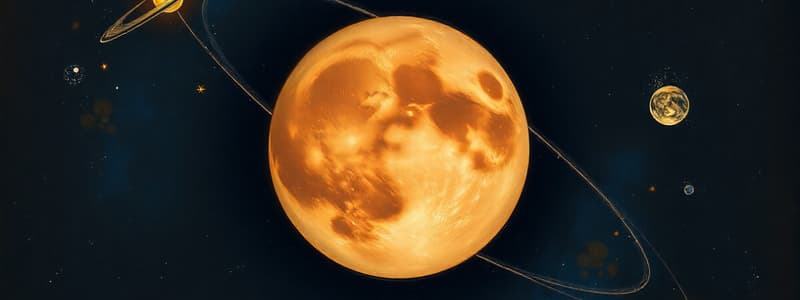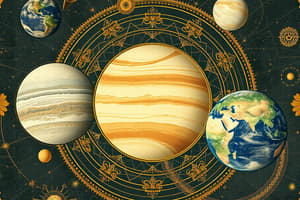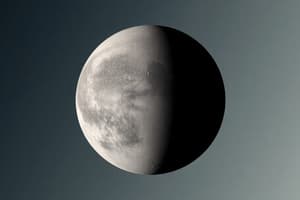Podcast
Questions and Answers
Approximately how long ago did Mercury form?
Approximately how long ago did Mercury form?
- 4.5 billion years ago (correct)
- 10 billion years ago
- 500 million years ago
- 2 billion years ago
Which of these is a feature of Mercury?
Which of these is a feature of Mercury?
- thick atmosphere
- liquid ocean
- A central core (correct)
- extensive ring system
Mercury is named after the Roman God of what?
Mercury is named after the Roman God of what?
- travel (correct)
- war
- fire
- agriculture
What is Mercury's ranking in size compared to the other planets in our solar system?
What is Mercury's ranking in size compared to the other planets in our solar system?
Which planet is hotter than Mercury?
Which planet is hotter than Mercury?
The surface of Mercury is most similar to which of these?
The surface of Mercury is most similar to which of these?
What are 'crater rays'?
What are 'crater rays'?
What is the highest daytime temperature on Mercury?
What is the highest daytime temperature on Mercury?
Why does Mercury experience extreme temperature variations?
Why does Mercury experience extreme temperature variations?
Where might water ice be found on Mercury?
Where might water ice be found on Mercury?
Approximately how fast does Mercury travel through space?
Approximately how fast does Mercury travel through space?
Approximately how long is a year on Mercury?
Approximately how long is a year on Mercury?
Approximately how long does it take Mercury to make one full rotation?
Approximately how long does it take Mercury to make one full rotation?
Which spacecraft was the first to fly by Mercury?
Which spacecraft was the first to fly by Mercury?
Which planet did Mariner 10 study while using its gravity to reach Mercury?
Which planet did Mariner 10 study while using its gravity to reach Mercury?
Which spacecraft was the first to orbit Mercury?
Which spacecraft was the first to orbit Mercury?
What did the MESSENGER mission confirm about Mercury's polar deposits?
What did the MESSENGER mission confirm about Mercury's polar deposits?
What is the name of the joint mission to Mercury by the European Space Agency and JAXA?
What is the name of the joint mission to Mercury by the European Space Agency and JAXA?
When is BepiColombo scheduled to begin orbiting Mercury?
When is BepiColombo scheduled to begin orbiting Mercury?
Which component of the BepiColombo mission will study Mercury's magnetic field?
Which component of the BepiColombo mission will study Mercury's magnetic field?
Flashcards
Mercury
Mercury
Smallest planet, closest to the Sun, with a central core, rocky mantle, and solid crust.
Mercury's Surface
Mercury's Surface
Greyish-brown with bright streaks called crater rays, lacks a thick atmosphere.
Mercury's Temperature
Mercury's Temperature
Ranges from 800°F (430°C) during the day to -290°F (-180°C) at night.
Water on Mercury
Water on Mercury
Signup and view all the flashcards
Mercury's Speed
Mercury's Speed
Signup and view all the flashcards
Mercury's Day and Year
Mercury's Day and Year
Signup and view all the flashcards
Mariner 10
Mariner 10
Signup and view all the flashcards
MESSENGER
MESSENGER
Signup and view all the flashcards
BepiColombo
BepiColombo
Signup and view all the flashcards
Mercury Planetary Orbiter (MPO)
Mercury Planetary Orbiter (MPO)
Signup and view all the flashcards
Mercury Magnetospheric Orbiter (MIO)
Mercury Magnetospheric Orbiter (MIO)
Signup and view all the flashcards
Study Notes
- Mercury was formed 4.5 billion years ago as gravity pulled gas and dust together.
- It is the planet closest to the Sun.
- Mercury, a terrestrial planet, has a central core, a rocky mantle, and a solid crust.
- Mercury is named after the Roman God of travel and is also known as Hermes, the Greek messenger god.
Characteristics
- Mercury is the smallest planet in our Solar System
- Mercury is a little bigger than Earth's Moon.
- It is the closest planet to the Sun, although Venus is hotter.
- Mercury has a solid surface with many craters like the Earth's Moon.
- Craters were formed early in the solar system's history due to collisions with meteoroids, comets, and asteroids.
- Mercury's surface appears greyish-brown.
- "Crater rays" are bright streaks formed when an asteroid or comet strikes the surface.
- Surface temperatures can reach 800 degrees Fahrenheit (430 degrees Celsius) during the day.
- Nighttime temperatures can drop to minus 290 degrees Fahrenheit (minus 180 degrees Celsius) due to a lack of atmosphere.
- Water ice is possible in deep craters at the north and south poles, in permanently shadowed regions.
- It travels through space at nearly 29 miles (47 kilometers) per second, making it the fastest planet.
- Mercury has the shortest year of all the planets in our solar system at 88 days.
- One rotation takes 59 Earth days
- A year on Mercury takes only 88 Earth days
Missions to mercury
- Two NASA missions have explored Mercury.
Mariner 10
- Mariner 10 was the first spacecraft to fly by Mercury.
- It also studied Venus and used Venus' gravity to change its speed and trajectory to reach Mercury.
MESSENGER
- MESSENGER was the first spacecraft to orbit Mercury.
- It discovered large amounts of water in Mercury's exosphere.
- The spacecraft orbited Mercury for more than four years.
- The mission determined Mercury’s surface composition and geological history
- It discovered details about its internal magnetic field.
- Polar deposits were verified to be dominantly water-ice.
- The mission ended when MESSENGER impacted Mercury’s surface.
BepiColombo
- Launched in October 2018 and is scheduled to begin orbiting Mercury in 2025.
- It is a joint mission by the European Space Agency (ESA) and JAXA.
- BepiColombo consists of two spacecraft: the Mercury Planetary Orbiter (MPO) and the Mercury Magnetospheric Orbiter (MIO).
- ESA built the Mercury Planetary Orbiter.
- JAXA supplied the Mercury Magnetospheric Orbiter.
- ESA's Mercury Planetary Orbiter (MPO) will study the planet's surface and interior.
- JAXA's Mercury Magnetospheric Orbiter (MIO) will study the planet's magnetic field.
- These are the first Mercury missions for the ESA and Japan.
Studying That Suits You
Use AI to generate personalized quizzes and flashcards to suit your learning preferences.




